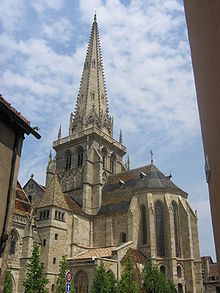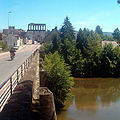Autun
| Autun | ||
|---|---|---|

|
|
|
| region | Bourgogne-Franche-Comté | |
| Department | Saône-et-Loire | |
| Arrondissement | Autun ( sub-prefecture ) | |
| Canton |
Autun-1 (main town) Autun-2 (main town) |
|
| Community association | Grand Autunois Morvan | |
| Coordinates | 46 ° 57 ' N , 4 ° 18' E | |
| height | 280-642 m | |
| surface | 61.52 km 2 | |
| Residents | 13,290 (January 1, 2017) | |
| Population density | 216 inhabitants / km 2 | |
| Post Code | 71400 | |
| INSEE code | 71014 | |
| Website | http://www.autun.com/ | |
 Autun Town Hall |
||
Autun [ Otoe ] is a French city with 13,290 inhabitants (at January 1, 2017) in Saône-et-Loire in the region of Bourgogne Franche-Comté and capital of the same name arrondissement .
geography
The city lies on the banks of the Arroux , at the confluence of its right tributary, the Ternin . Autun is known as the “gateway to the Morvan massif”. The dark forests of this area almost reach the choir of the Saint-Lazare cathedral, which is covered with stained-glass tiles .
history
The ancient name of Autun was Augustodunum , which was given by Emperor Augustus around 10 BC. BC on the long-distance trade route Via Agrippa and the Arroux river after the resistance of the Gauls was finally broken. The Augustodunum located in the plain corresponded to the Roman city model in contrast to the Bibracte , which was located on a hill , which was 25 kilometers away from Augustodunum and had previously been the capital of the Haedu tribe . After the establishment of Augustodunum, Bibracte was gradually abandoned through emigration. The majority of the former inhabitants of Bibracte are likely to have settled in Augustodunum, u. a. part of the Haedu upper class, which was already pre-Roman during the Gallic War : They certainly registered the strategic importance of the new city, which was located on the main traffic axes. Even in pre-Roman times, a druid sanctuary is said to have been located in the city area. The city has not grown beyond the ancient dimensions (200 ha). It was once called the "Rome" of Gaul.
Until the end of the 3rd century Augustodunum enjoyed great prosperity. It was known as a seat of learning and had a famous school of rhetoric. In 269 AD it was stormed and devastated by Victorinus after seven months of siege. After that, the city went into decline, but remained a cultural center because of its schools. In the 3rd century Augustodunum also became the seat of a diocese . 356 besieged the Alemanni the city, however, Julian horrified. In 451 it was devastated by Attila .
The medieval city wall , of which 23 towers have been preserved, is based on ancient foundations (six kilometers long, 54 defensive towers). Of the four main gates, the Porte d'Arroux still stands in the north-west (double portal with barrel-vaulted passages, upper floor with fluted columns in front of it ) and the Porte Saint-André in the north-east (high and low passages like the first gate, clad with sandstone blocks, approaches a courtyard on the city side). From Roman times only the theater , the largest in all of Gaul, the Pyramid de Couhard , a tomb from the 1st century, and outside the city the heavily damaged so-called Janus temple .
In 532 an important battle took place at the gates of the city in which the Franks defeated the Burgundians ; their empire was annexed by the Frankish empire. After that, Autun functioned as the Frankish capital until it was sacked by the Arabs (725/28). In the year 725 the Umayyad general Anbassa ibn Suhaym al-Kalbi came with his army to Autun. On August 22, 725 he conquered the city. Autun was the easternmost point of the Umayyad expansion in Europe.
Between 663 and 675 a council took place in Autun , which was initiated by Bishop Leodegar von Autun : "From the files of this only fragmentary council no date emerges, but the Bishop Leodegar von Autun is named as its initiator." among other things, that for orders the adoption of the rule of Benedict was required.
In 888 Normans looted and ravaged Autun. The city already had its own counts , of whom Richard the judge was raised to Duke of Burgundy by Charles the Simple in 918 . The council held in Autun in 1094 excommunicated King Philip I for rejecting his wife Bertha . In the 12th century the important Romanesque cathedral of St-Lazare was built. Autun remained the residence of the Dukes of Burgundy until 1276. It was cremated by the English in 1379 during the Hundred Years War . In 1591, because of their support for the Catholic League , the inhabitants of the city had a siege by Marshal Jean VI. d'Aumont , a general of King Henry IV .
In 1788 Charles-Maurice de Talleyrand-Périgord became Bishop of Autun and remained so until the outbreak of the French Revolution in 1789. He was later Napoleon's Foreign Minister.
Attractions
Architectural monuments
See also: List of Monuments historiques in Autun
from the Gallo-Roman period:
- City wall: built on Roman foundations
- ancient city gates Porte d'Arroux and Porte Saint-André
- so-called Janus temple : was erroneously assigned to the god Janus; a plaque on the building specifies: "The special shape of the temple, called fanum, is of Gallic origin, only the stone-cutting technique is Roman and dates from the 1st century AD. The name Janus was incorrectly associated with the temple when it was in the 16th century Century the historian Pierre de Saint-Julien interpreted the name of the place (French: la Genetoye). In fact, this place name referred to a locality where gorse bushes (Cytisus Genista) grew. The deity who was worshiped here is completely unknown to this day. " (Translated from the English text on the display board)
- Roman theater with a diameter of 148 m and approx. 15,000 seats; the orchestra and some of the tiers have been exposed
- roman amphitheater
from the Middle Ages:
- St-Lazare Cathedral from the 12th century in the Burgundian Romanesque style
- The donjon from the 12th century called the Tour des Ursulines , the only remnant of the once impressive Riveau castle, now a cultural center
- medieval houses with the city palace of the Chancellor of the Dukes of Burgundy, Nicolas Rolin (* 1376 Autun), in which the Musée Rolin was established
Further worth seeing
- Rolin Museum
- Muséum d'histoire naturelle d'Autun : natural science museum with over 800,000 species, in rue Saint-Antoine
- Lycée militaire d'Autun : former seminary with an earlier cloister (17th century); Napoléon and his brother Joseph enjoyed part of their training here
- Passage: splendid covered passage on Rue du Général du Demetz
- Croix de la Liberation: a stone cross commemorating the liberation of the city in 1944 on the Mont Saint-Sebastien hill southwest of Autun , from which one has a good view over the city
- The Champ de la Justice stone row is north of Autun.
Personalities
Born in Autun
- Symphorianus (*? - 178), Christian martyr
- Eumenius (around 264 – around 312), Gallic rhetorician of late antiquity
- Euphronius von Autun , bishop of the city (approx. 451 to 475)
- Germanus of Paris (496-576), Bishop of Paris
- Nicolas Rolin (1376–1462), Chancellor of Philip the Good
- Nicolas Changarnier (1793–1877), French general
- Jacques Gabriel Bulliot (1817–1902), wine merchant and amateur archaeologist
- François-Xavier Gillot (1842–1910), French botanist
- Louis Renault (1843–1918), French lawyer and Nobel Peace Prize laureate
- Olivier Dupard (* 1965), racing car driver
People related to the city
- Gregor von Langres , in the 2nd half of the 5th century comes the city
- Brunichild (545 / 550–613), Queen of the Franks, was buried in Autun
- Leodegar (616–679), Bishop of Autun
- Honorius von Autun (* approx. 1080; † 1150 or 1151), theologian, philosopher
- Talleyrand (1754–1838), from 1788 bishop in the diocese of Autun
- Napoleon Bonaparte (1769–1821) attended the collège here for a year
- Joseph Bonaparte (1768–1844), Napoleon's eldest brother, attended the collège here for a year
- Siegfried Thomaschki (1894–1967), as Colonel of the Wehrmacht in 1940 city commander
Town twinning
- Ingelheim am Rhein , Rhineland-Palatinate , Germany, since 1963
- Stevenage , Hertfordshire , United Kingdom, since 1975
- Kawagoe , Saitama Prefecture , Japan, since 2002
- Arévalo , Castile-Leon , Spain
particularities
A culinary specialty of the region are the products of the Morvan (granite massif in the Bourgogne), such as cheese, honey and hazelnut products , such as the Noisettes du Morvan, a nut pastry in the form of nuts and Gros Croquets du Morvan, an almond and nut Pastries.
literature
- Maximilian Ihm : Augustodunum . In: Paulys Realencyclopadie der classischen Antiquity Science (RE). Volume II, 2, Stuttgart 1896, Col. 2368.
- Johann Baptist Keune : Autun . In: Paulys Realencyclopadie der classischen Antiquity Science (RE). Supplement volume III, Stuttgart 1918, col. 191.
Web links
Individual evidence
- ↑ Roland Martin : Augustodunum (Autun) Saône-et-Loire, France. . In: Richard Stillwell et al. a. (Ed.): The Princeton Encyclopedia of Classical Sites. Princeton University Press, Princeton NJ 1976, ISBN 0-691-03542-3 .
- ^ Yves Lafond: Augustodunum. In: The New Pauly (DNP). Volume 2, Metzler, Stuttgart 1997, ISBN 3-476-01472-X , Sp. 301 .; Augustodunum. In: Hellmut Brunner, Klaus Flessel, Friedrich Hiller (Hrsg.): Lexicon old cultures. Volume 1, Meyers Lexikonverlag, Mannheim 1990, ISBN 3-411-07301-2 , p. 243.
- ↑ a b Autun . In: Meyers Konversations-Lexikon . 4th edition. Volume 2, Verlag des Bibliographisches Institut, Leipzig / Vienna 1885–1892, p. 174.
- ↑ Rom. Remains according to: B. Laule, U. Laule, H. Wischermann: Kunstdenkmäler in Burgund. Scientific Book Society, Darmstadt 1991, p. 359.
- ^ Hubert Mordek : Canon Law and Reform in the Franconian Empire: The Collectio Vetus Gallica, the oldest systematic canon collection of Franconian Gaul. Berlin 1975, p. 84 ff.
- ↑ Odette Pontal: The Synods in the Merovingian Empire. Paderborn et al. 1986, p. 197.
- ↑ Autun. In: Encyclopædia Britannica . 11th edition. 1910-11, Volume 3, p. 49.













